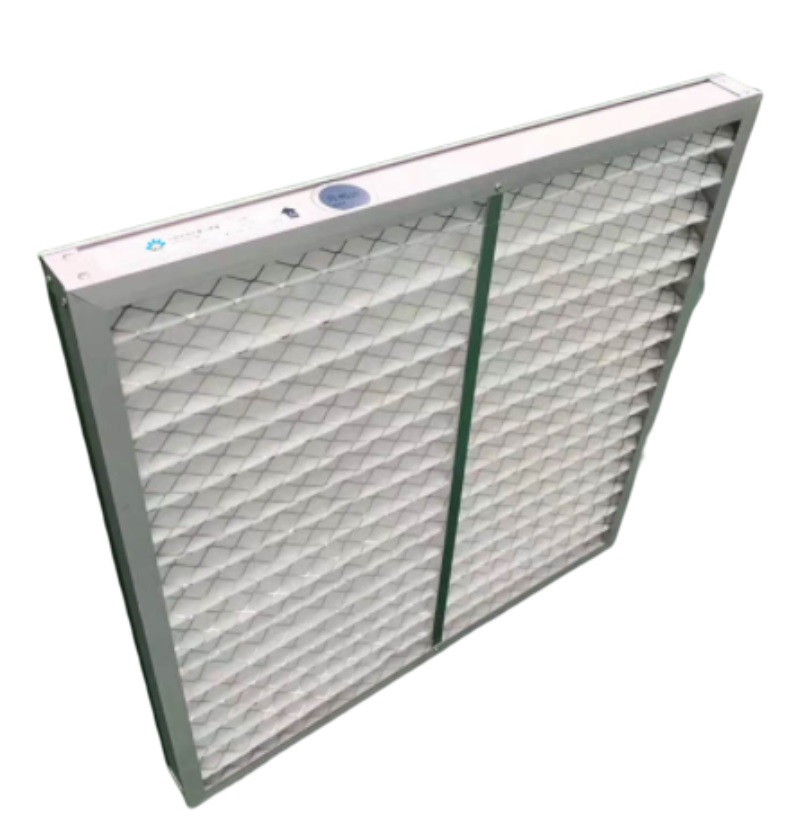
The 20x20x1 Air Filter is a standard-sized HVAC Filter designed to improve indoor air quality by capturing dust, pollen, pet dander, and other airborne particles. Measuring 20 inches in width, 20 inches in height, and 1 inch in depth, it fits most residential and commercial air handling systems. Constructed with pleated or fiberglass media, it offers efficient filtration while maintaining airflow. Ideal for homes, offices, and light industrial use, this filter helps reduce allergens and prolongs HVAC system life. Regular replacement (every 1-3 months) ensures optimal performance. Choose from MERV 8-13 ratings based on filtration needs.

Specifications
| Product Name: | 20x20x1 Air Filter |
| Frame: | Aluminum frame (optional galvanized frame, stainless steel frame) |
| Filter Material: | High quality polymerase synthetic fiber |
| Filtration Efficiency: | G3/G4/M5 (EN779) |
| Fire Rating: | UL900 Certification |
| Continuous Operating Temperature: | ≤70°C |
| Recommended Final Resistance: | <250pa<> |
| Main Application: | Pre-filtration of Commercial and Industrial Ventilation and Air Conditioning Systems |
| Protection Net: | Barbed Wire |
Dimensioning
Nominal Size(Inch) W×H×D (mm) | Actual Size(mm) W×H×D (mm) | Rated Initial Resistance(Pa) | Rated Face Velocity(m/s) | |
G3 | G4 | |||
12x24x1 | 289x594x22 | 63 | 75 |
2.5 |
20x24x1 | 492x594x22 | 63 | 75 | |
24x24x1 | 594x594x22 | 63 | 75 | |
12x24x2 | 289x594x46 | 45 | 55 | |
20x24x2 | 492x594x46 | 45 | 55 | |
24x24x2 | 594x594x46 | 45 | 55 | |
12x24x4 | 289x594x96 | 38 | 43 | |
20x24x4 | 492x594x96 | 38 | 43 | |
24x24x4 | 594x594x96 | 38 | 43 | |
Resistance maximum deviation range: ±15%
Primary Filter non-standard size can be customized according to customer needs
Features
1. MERV Rating for Enhanced Filtration
This filter boasts a MERV 8-13 rating, capturing 70-90% of airborne particles between 3.0-10.0 microns, including dust, pollen, and mold spores. The 20x20x1 size ensures compatibility with standard HVAC systems while balancing filtration efficiency (tested per ASHRAE 52.2 standards) with minimal pressure drop (typically 0.10-0.25 in. w.c. at 500 FPM).
2. Pleated Design for Maximum Surface Area
Featuring 28-32 pleats per foot, the filter provides 4.2 sq. ft. of effective filtration media within its compact 1" frame. The synthetic media (often polypropylene or polyester blend) maintains 85-95% dust-holding capacity (per ISO 16890 testing) without restricting airflow below 300 CFM at standard velocities.
3. Electrostatic Charge Technology
Advanced models incorporate electret media with a 12-15 kV electrostatic charge, increasing sub-micron particle capture by 40-60% compared to mechanical filtration alone. This technology demonstrates 98% efficiency on 0.3-1.0 micron particles (tested via ASTM F2299) while maintaining a 0.8-1.2 air resistance ratio.
4. Structural Integrity Under Pressure
The filter's dual-layer wire mesh or rigid polymer frame withstands 1.5-2.0 psi differential pressure without deformation (per AHRI 680 testing). The cross-linked adhesive bonds maintain pleat integrity at temperatures up to 200°F (93°C) and 80% relative humidity conditions.
5. Antimicrobial Treatment Options
Optional silver-ion or photocatalytic coatings inhibit microbial growth with 99% reduction in bacterial colonies (per ASTM E2149). These treatments remain effective for the filter's 3-6 month service life without impacting airflow characteristics (verified via ISO 16890:2016 testing).
6. Energy Efficiency Compliance
Designed to meet ENERGY STAR® Most Efficient 2023 criteria, these filters contribute to HVAC system efficiency with less than 5% increase in energy consumption compared to unfiltered systems (verified through DOE 10 CFR 430 testing). The aerodynamic media spacing (typically 4.5-5.5 mm between pleats) optimizes the balance between filtration and energy use.
Is to capture and remove airborne particles and contaminants from the air circulating through your HVAC system. This includes dust, pollen, pet dander, mold spores, and other allergens. It also helps prevent larger debris from entering and potentially damaging your HVAC equipment.
How Often Should A 20x20x1 Air Filter Be Cleaned?
Regularly replacing or cleaning your 20x20x1 air filter is essential for maintaining efficient HVAC system operation and improving indoor air quality. How often you need to replace or clean the filter depends on factors such as your local air quality, the presence of pets, and the filter's type (e.g., disposable fiberglass or reusable washable).
20x20x1 Air Filter How To Clean?
Cleaning a 20x20x1 air filter involves gently vacuuming or washing it with mild soap and water. Ensure it's completely dry before reinstalling.
What Are The Advantages Of 20x20x1 Air Filter?
Advantages of a 20x20x1 air filter include improved indoor air quality, reduced allergens, and enhanced HVAC system efficiency.
In summary, a 20x20x1 air filter is a standard-sized filter that plays a vital role in keeping the air in your home clean and your HVAC system running smoothly. Regular maintenance of these filters is important for optimal performance and air quality.